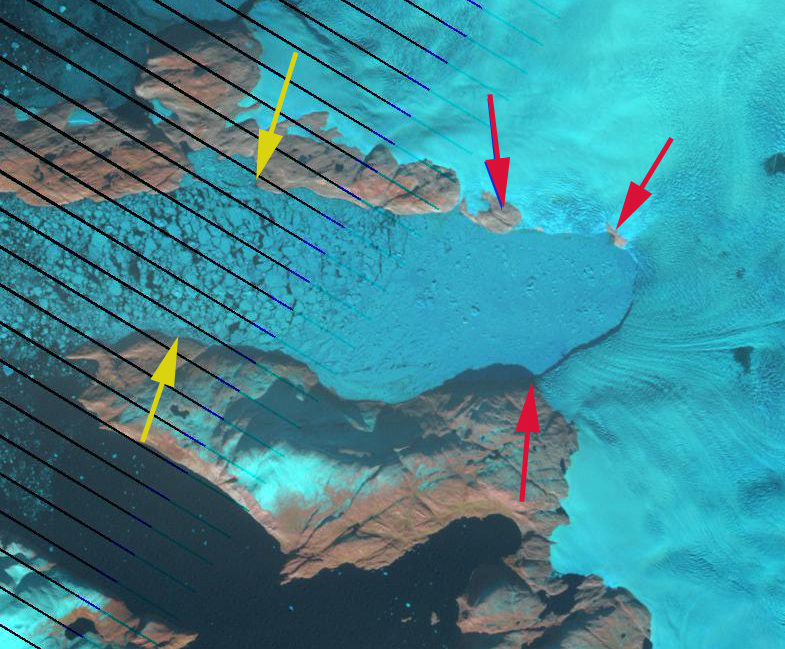August 19, 2012
Alison Gletscher, NW Greenland Rapid Retreat
Posted by Mauri Pelto
Returned from the field yesterday. There was spectacular melting and forest fires in our field area of the North Cascades, Washington. Preliminary results will follow in 10 days. Alison Gletscher in western Greenland at 74.37 N and 56.08 W,had a spectacular retreat in the last decade. The 11 km retreat has been noted by Howat and Eddy (2011) and Joughin et al, (2010). The velocity of the glacier is typical of marine outlet glaciers increasing dramatically near the ice front to 3000 meters/year, image from Joughin et al, (2010).  The recent increases in outlet glacier discharge have always been coincident with floating tongue losses. This causes reduced back pressure at the glacier front, letting up on the brakes; the resulting glacier thinning leads to less basal friction and further acceleration. If the glacier front retreats into deeper water the process will continue and increase. The acceleration is driven by changes at the calving front not by meltwater lubrication (Joughin et al, 2010and Bailey and Pelto, 2011. This post examines a 2000 and 2011 Landsat image of the glacier, the yellow arrows indicate the 2000 terminus and the red arrows the 2011 terminus location.
The recent increases in outlet glacier discharge have always been coincident with floating tongue losses. This causes reduced back pressure at the glacier front, letting up on the brakes; the resulting glacier thinning leads to less basal friction and further acceleration. If the glacier front retreats into deeper water the process will continue and increase. The acceleration is driven by changes at the calving front not by meltwater lubrication (Joughin et al, 2010and Bailey and Pelto, 2011. This post examines a 2000 and 2011 Landsat image of the glacier, the yellow arrows indicate the 2000 terminus and the red arrows the 2011 terminus location. 
 . The glacier’s calving front is much longer than in 2000, however, there are a number of pinning points, purple arrows in image below that reduce the glacier velocity on the northern and southern margin. However, the high velocity, extensively crevassed middle section is still retreating.
. The glacier’s calving front is much longer than in 2000, however, there are a number of pinning points, purple arrows in image below that reduce the glacier velocity on the northern and southern margin. However, the high velocity, extensively crevassed middle section is still retreating.  . MODIS imagery from 2012 indicates limited change to date this summer in the terminus position of Alison Gletscher, below is the August 9th image. This glacier is retreating similar to Kong OscarUpernavik and Epiq Sermia
. MODIS imagery from 2012 indicates limited change to date this summer in the terminus position of Alison Gletscher, below is the August 9th image. This glacier is retreating similar to Kong OscarUpernavik and Epiq Sermia


 Dean of Academic Affairs at Nichols College and Professor of Environmental Science at Nichols College in Massachusetts since 1989. Glaciologist directing the North Cascade Glacier Climate Project since 1984. This project monitors the mass balance and behavior of more glaciers than any other in North America.
Dean of Academic Affairs at Nichols College and Professor of Environmental Science at Nichols College in Massachusetts since 1989. Glaciologist directing the North Cascade Glacier Climate Project since 1984. This project monitors the mass balance and behavior of more glaciers than any other in North America.